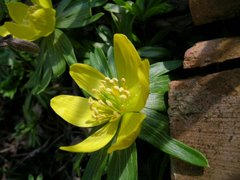Eranthis
| {{{name}}} LATINNAME
|
'
| ||||||||||||||||||||||||||||||||||||||||
|---|---|---|---|---|---|---|---|---|---|---|---|---|---|---|---|---|---|---|---|---|---|---|---|---|---|---|---|---|---|---|---|---|---|---|---|---|---|---|---|---|---|

|
|
| |||||||||||||||||||||||||||||||||||||||
| |||||||||||||||||||||||||||||||||||||||||
| Standard Cyclopedia of Horticulture |
|---|
|
Eranthis (Greek, er. spring, and anthos, a flower; from the early opening of the flowers). Ranunculaceae. Winter Aconite. Low perennial herbs, grown in open flower-beds because of the very early show of bright flowers; very desirable. Rootstock tuberous: basal lvs. palmately dissected, 1 st.-lf. sessile or amplexicaul just beneath the large yellow fl.: sepals 5-8, petal-like; petals small, 2-lipped nectaries; stamens numerous: carpels few, stalked, many-ovuled, becoming follicles.—About 7 species, natives of Eu. and Asia. The earliest generic name is Cammarum which was given in Hill's British Herbal, p. 47, pl. 7 (1756), but it is not accepted by the "nomina conservanda" of the Vienna code. Winter aconites are very hardy, and at home in half-shady places, among shrubs or in the border. Propagated by division of roots. The place in which the tubers are planted should be marked during the summer, when the foliage is dead.
|
Cultivation
- Do you have cultivation info on this plant? Edit this section!
Propagation
- Do you have propagation info on this plant? Edit this section!
Pests and diseases
- Do you have pest and disease info on this plant? Edit this section!
Species
- Specieswp
- Eranthis albiflora. Western China.
- Eranthis cilicica. Southwestern Asia.
- Eranthis hyemalis. Southern Europe.
- Eranthis lobulata. Western China.
- Eranthis longistipitata. Central Asia.
- Eranthis pinnatifida. Japan.
- Eranthis sibirica. Northern Asia.
- Eranthis stellata. Eastern Asia (northern China, Korea, southeast Russia).
Gallery
If you have a photo of this plant, please upload it! Plus, there may be other photos available for you to add.
References
- Standard Cyclopedia of Horticulture, by L. H. Bailey, MacMillan Co., 1963
External links
- w:Eranthis. Some of the material on this page may be from Wikipedia, under the Creative Commons license.
- Eranthis QR Code (Size 50, 100, 200, 500)

